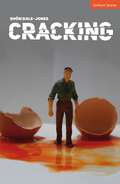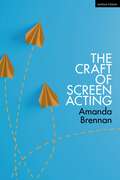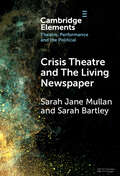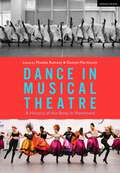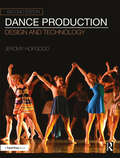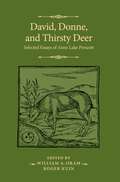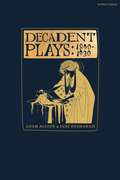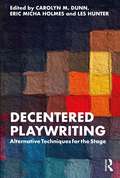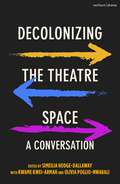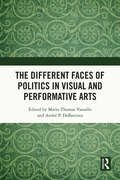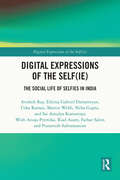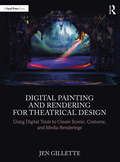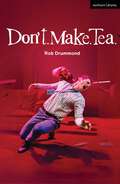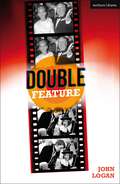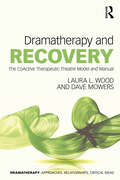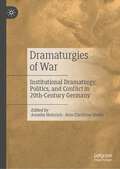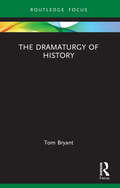- Table View
- List View
Cracking (Modern Plays)
by Shôn Dale-JonesAs I walk past the funeral parlour, I see a poster next to their two-for-one offer. It's a wanted poster with my name on it.A completely made-up true story. When the world goes mad, do we inevitably go mad too?When Shôn playfully cracks an egg on his mother's head, he has no idea real-life internet trolls will appear on his doorstep. Cracking takes on the battle between love and hate, asking what's funny and where we draw the line. Part stand-up, part theatre, Cracking is a funny, touching and thought-provoking solo performance that sews together fact and fiction into one seamless whole making us wonder what's real, what's not and what's gone wrong. This story about love and hatred celebrates how searching for connection beats disconnecting. This edition was published to coincide with the UK tour starting in February 2024.
The Craft of Screen Acting
by Amanda BrennanHave you been working as an actor, but want to refine your craft and take your performance to the next level? Or do you want to transition from stage to screen acting and would like to better understand the skills required? In this essential book for actors, Amanda Brennan offers a specifically psychophysical approach to screen acting, which provides an understanding of the body as the springboard for creative exploration. Starting with understanding your own instrument, you will learn how to prepare and tune the body for creative work. This is followed by strategies for the refinement of craft, including exercises on voice, movement, character development and rehearsal processes for screen. Experienced actors, directors, casting directors and industry professionals, such as Asa Butterfield (The Boy in the Striped Pajamas, Hugo, Sex Education), Noah Jupe (Honey Boy, The Quiet Place,The UnDoing), Janis Pugh (Chuck Chuck Baby) and James Kent (Testament of Youth, The Aftermath) and Rebecca Lloyd offer their comments and share invaluable experiences throughout the book.
Crisis Theatre and The Living Newspaper (Elements in Theatre, Performance and the Political)
by null Sarah Jane Mullan null Sarah BartleyCrisis Theatre and The Living Newspapers traces a history of the living newspaper as a theatre of crisis from Soviet Russia (1910s), through the Federal Theatre Project of the Great Depression in America (1930s), to Augusto Boal's teatro jornal in Brazil (1970s), and its resonance with documentary forms deployed in the final years of apartheid in South Africa (1990s), up until the present day in the UK (2020s). Across this Element, the author is interested in what a transnational and transhistorical examination of the living newspaper through the lens of crisis reveals about the ways in which theatre can intervene in our collective social, economic and political life. By holding these diverse examples together, the author asserts the Living Newspaper as a form of Crisis Theatre.
Dance in Musical Theatre: A History of the Body in Movement
by Dustyn Martincich and Phoebe RumseyFrom Oklahoma! and West Side Story, to Spring Awakening and Hamilton, dance remains one of the most important and key factors in musical theatre. Through the integration of song and dance in the 'dream ballets' of choreographers like Agnes De Mille; the triple threat performances of Jerome Robbins' dancers; the signature style creation by choreographers like Bob Fosse with dancers like Gwen Verdon; and the contemporary, identity-driven work of choreographers like Camille A. Brown, the history of the body in movement is one that begs study and appreciation. Dance in Musical Theatre offers guidelines in how to read this movement by analyzing it in terms of composition and movement vocabulary whilst simultaneously situating it both historically and critically. This collection provides the tools, terms, history, and movement theory for reading, interpreting, and centralizing a discussion of dance in musical theatre, importantly, with added emphasis on women and artists of color. Bringing together musical theatre and dance scholars, choreographers and practitioners, this edited collection highlights musical theatre case studies that employ dance in a dramaturgically essential manner, tracking the emergence of the dancer as a key figure in the genre, and connecting the contributions to past and present choreographers. This collection foregrounds the work of the ensemble, incorporating firsthand and autoethnographic accounts that intersect with historical and cultural contexts. Through a selection of essays, this volume conceptualizes the function of dance in musical: how it functions diegetically as a part of the story or non-diegetically as an amplification of emotion, as well as how the dancing body works to reveal character psychology by expressing an unspoken aspect of the libretto, embodying emotions or ideas through metaphor or abstraction.Dance in Musical Theatre makes dance language accessible for instructors, students, and musical theatre enthusiasts, providing the tools to critically engage with the work of important choreographers and dancers from the beginning of the 20th century to today.
Dance Production: Design and Technology
by Jeromy HopgoodDance Production: Design and Technology, Second Edition is an introduction to the skills needed to plan, design, and execute the technical aspects of a dance production.Covering a broad range of topics, author Jeromy Hopgood takes the reader through the process of producing dance from start to finish. Part I addresses the collaborative process, business and organizational concerns for dance companies, planning the production, and the relationship between dance and performance spaces/staging methods. In Part II, each unique production area is examined, including production and stage management, sound, costume and makeup, scenery and props, lighting, and projection/video design. Each design area is divided into two chapters – the first introducing key concepts, and the second focusing on the process of creating the design. Part III brings back the popular quick reference guides from the first edition, providing an expanded and revised tool to bridge the language gap between the worlds of theatrical production and dance, and ensure productive communication across the different fields. This second edition features updated information on technology and processes, two new chapters on touring and non-traditional productions, more information on arts management within dance production, a comprehensive look at dance and video (including remote/streaming performances, as well as dance film), and additional chapter projects throughout the book.This unique book approaches the process of staging a dance production from a balanced perspective, making it an essential resource for choreographers, theatre designers, dancers, and management personnel alike, including for use in Dance and Dance Production courses.
Dance Production: Design and Technology
by Jeromy HopgoodDance Production: Design and Technology, Second Edition is an introduction to the skills needed to plan, design, and execute the technical aspects of a dance production.Covering a broad range of topics, author Jeromy Hopgood takes the reader through the process of producing dance from start to finish. Part I addresses the collaborative process, business and organizational concerns for dance companies, planning the production, and the relationship between dance and performance spaces/staging methods. In Part II, each unique production area is examined, including production and stage management, sound, costume and makeup, scenery and props, lighting, and projection/video design. Each design area is divided into two chapters – the first introducing key concepts, and the second focusing on the process of creating the design. Part III brings back the popular quick reference guides from the first edition, providing an expanded and revised tool to bridge the language gap between the worlds of theatrical production and dance, and ensure productive communication across the different fields. This second edition features updated information on technology and processes, two new chapters on touring and non-traditional productions, more information on arts management within dance production, a comprehensive look at dance and video (including remote/streaming performances, as well as dance film), and additional chapter projects throughout the book.This unique book approaches the process of staging a dance production from a balanced perspective, making it an essential resource for choreographers, theatre designers, dancers, and management personnel alike, including for use in Dance and Dance Production courses.
David, Donne, and Thirsty Deer: Selected Essays of Anne Lake Prescott (The Manchester Spenser)
by Anne Lake PrescottFor nearly half a century Anne Lake Prescott has been a force and an inspiration in Renaissance studies. A force, because of her unique blend of learning and wit and an inspiration through her tireless encouragement of younger scholars and students. Her passion has always been the invisible bridge across the Channel: the complex of relations, literary and political, between Britain and France. The essays in this long-awaited collection range from Edmund Spenser to John Donne, from Clément Marot to Pierre de Ronsard. Prescott has a particular fondness for King David, who appears several times; and the reader will encounter chessmen, bishops, male lesbian voices and Roman whores. Always Prescott’s immense erudition is accompanied by a sly and gentle wit that invites readers to share her amusement. Reading her is a joyful education.
Decadent Plays: Salome; The Race of Leaves; The Orgy: A Dramatic Poem; Madame La Mort; Lilith; Ennoïa: A Triptych; The Black Maskers; La Gioconda; Ardiane and Barbe Bleue or, The Useless Deliverance; Kerria Japonica; The Dove
by Adam Alston and Jane DesmaraisPoisoned cigars, seductive apparitions, minds and empires in the last of their decline and the most notorious kiss in dramatic history – decadent plays challenged the moral as much as the dramatic imagination of their own day, and continue to probe horizons of taste and the possibilities of stagecraft. In the late 19th and early 20th centuries, many writers reacted to urban modernity by embracing decadent themes and styles, and dramatists were no exception. Decadence offered these writers a framework for exploring nonconformist identities and beliefs that challenged behavioural norms as much as the desirability of modern progress. Decadent plays were at once behind the times in their celebration of antiquity, and forward-thinking in their staging of themes that have become all the more timely in the 21st century, including queerness, unconventional eroticism, and critiques of empire and industrial progress. Equally, the diversity of decadent drama cannot be pigeon-holed; many of these plays still have the capacity to offend worldviews, and invite us to interrogate present-day conventions and propriety. International in scope and eclectic in content, this edited anthology is an authoritative and accessible introduction to a fast-expanding field of decadent literature. The first publication of its kind to deal with decadent drama, and featuring plays translated into English for the first time, Decadent Plays: 1890 to 1930 breaks new ground by foregrounding decadence as a dramatic sensibility in this most pivotal of periods in the history of modern drama. Featuring canonical and little-known works by Oscar Wilde, Michael Field, Lesya Ukrainka, Rachilde, Remy de Gourmont, Jean Lorrain, Leonid Andreyev, Gabriele D'Annunzio, Maurice Maeterlinck, Izumi Kyoka, and Djuna Barnes, this anthology is an essential introduction to decadent drama that will pique the interest of specialists and non-specialists alike.
Decentered Playwriting: Alternative Techniques for the Stage
Decentered Playwriting investigates new and alternative strategies for dramatic writing that incorporate non-Western, Indigenous, and underrepresented storytelling techniques and traditions while deepening a creative practice that decenters hegemonic methods. A collection of short essays and exercises by leading teaching artists, playwrights, and academics in the fields of playwriting and dramaturgy, this book focuses on reimagining pedagogical techniques by introducing playwrights to new storytelling methods, traditions, and ways of studying, and teaching diverse narratological practices. This is a vital and invaluable book for anyone teaching or studying playwriting, dramatic structure, storytelling at advanced undergraduate and graduate levels, or as part of their own professional practice.
Decentered Playwriting: Alternative Techniques for the Stage
by Carolyn M. DunnDecentered Playwriting investigates new and alternative strategies for dramatic writing that incorporate non-Western, Indigenous, and underrepresented storytelling techniques and traditions while deepening a creative practice that decenters hegemonic methods. A collection of short essays and exercises by leading teaching artists, playwrights, and academics in the fields of playwriting and dramaturgy, this book focuses on reimagining pedagogical techniques by introducing playwrights to new storytelling methods, traditions, and ways of studying, and teaching diverse narratological practices. This is a vital and invaluable book for anyone teaching or studying playwriting, dramatic structure, storytelling at advanced undergraduate and graduate levels, or as part of their own professional practice.
Decolonizing the Theatre Space: A Conversation
by Simeilia Hodge-Dallaway Kwame Kwei-Armah Olivia Poglio-Nwabali2020 was a year in which global politics radically shifted, catalyzed by the Covid-19 pandemic and the #BlackLivesMatter movement. This book is a response to that year, asking: was it a moment or is it a movement, and what fundamental changes within the arts industry need to come out of this time? The book includes over 20 interviews with some of the most pioneering Black cultural leaders from a wide range of senior executive positions in the arts within the UK, Europe, US and Africa. It documents the sea of change in arts leadership at the height of the #BlackLivesMatter movement, the pressure on organizations to confront and change their racial and ethnic make-up, and shines a light on the guiding ambitions, strategic plans and visions for the future to support the ongoing decolonization of arts organizations across the world. Learn from those who have walked the walk to support your vision for the future.
Die dunkle Seite des Spiels: Theater zwischen Spiel, Wirklichkeit und Fiktion (Theater #161)
by Gunter LöselSpiel und Theater sind vielfältig verbunden, aber solange der Spielbegriff mit Harmlosigkeit assoziiert ist, nimmt er dem Theater Schärfe und Wirksamkeit. Gunter Lösel fragt deshalb nach einer Begriffserweiterung, die auch die dunkle Seite des Spiels umfasst. Zwischen Spiel, Wirklichkeit und Fiktion entwickelt er ein »Dreiweltenmodell des Theaters« und geht der Frage nach, warum die Spezies Mensch ein performatives Spiel entwickelt hat, in welchem sie sich negative Handlungen oder konflikthafte Situationen vor Augen führt. Durch Verbindungen zu Spieltheorie, Gaming, Philosophie, Performance-Studies und KI entsteht ein Reflexionsraum, der so den Widerspruch zwischen Harmlosigkeit des Spiels und Wirkungsmacht des Theaters auflöst.
The Different Faces of Politics in the Visual and Performative Arts
by Mario Thomas Vassallo Andre P. DebattistaThis book highlights the linkages between politics and governance and the arts. The essays in the volume show how visual and performative arts have challenged those in power — or conversely patronised by them — been used for propaganda, stir up national fervour and found themselves at the receiving end of political censure. They focus on the tension and symbiosis between the politician and the artist foregrounding how they have always tried to influence, challenge, and, in some cases, undermine one another. This volume will serve as an indispensable source for researchers and academics in political science, the humanities and performing arts.
The Different Faces of Politics in the Visual and Performative Arts
by Mario Thomas Vassallo André P. DeBattistaThis book highlights the linkages between politics and governance and the arts. The essays in the volume show how visual and performative arts have challenged those in power — or conversely patronised by them — been used for propaganda, stir up national fervour and found themselves at the receiving end of political censure. They focus on the tension and symbiosis between the politician and the artist foregrounding how they have always tried to influence, challenge, and, in some cases, undermine one another. This volume will serve as an indispensable source for researchers and academics in political science, the humanities and performing arts.
Digital Expressions of the Self(ie): The Social Life of Selfies in India
by Avishek Ray Ethiraj Gabriel Dattatreyan Usha Raman Martin Web Neha Gupta Sai Amulya Komarraju Anuja Premika Riad Azam Farhat Salim Pranavesh SubramanianThe book examines the social and cultural role of selfies in India. It looks at how the selfie, unlike the photograph, which was a gesture towards an external reality, remains intimately self-referential, yet reconfigures social ordering, identity formation, agency, and spaces in curious ways. This volume approaches questions about the construction and performance of the self through the digital selfie and uses this situated, contextualized, and culturally specific phenomenon as a site to explore the themes of self-making, place-making, gender, subjectivity, and power. Highlighting the specific contexts of production, the authors examine the array of self-expressive capabilities realized in a multitude of uses of the selfie that simultaneously reconfigure the self, the space, and the world. An important study of visual social media culture, the volume will be useful for interpreting everyday media experiences and will be of interest to students and researchers of image studies, visual studies, photography studies, visual culture, media studies, culture studies, cultural anthropology, digital humanities, popular culture, sociology of technology, and South Asian studies.
Digital Expressions of the Self(ie): The Social Life of Selfies in India
by Avishek Ray Ethiraj Gabriel Dattatreyan Usha Raman Martin Web Neha Gupta Sai Amulya Komarraju Anuja Premika Riad Azam Farhat Salim Pranavesh SubramanianThe book examines the social and cultural role of selfies in India. It looks at how the selfie, unlike the photograph, which was a gesture towards an external reality, remains intimately self-referential, yet reconfigures social ordering, identity formation, agency, and spaces in curious ways. This volume approaches questions about the construction and performance of the self through the digital selfie and uses this situated, contextualized, and culturally specific phenomenon as a site to explore the themes of self-making, place-making, gender, subjectivity, and power. Highlighting the specific contexts of production, the authors examine the array of self-expressive capabilities realized in a multitude of uses of the selfie that simultaneously reconfigure the self, the space, and the world. An important study of visual social media culture, the volume will be useful for interpreting everyday media experiences and will be of interest to students and researchers of image studies, visual studies, photography studies, visual culture, media studies, culture studies, cultural anthropology, digital humanities, popular culture, sociology of technology, and South Asian studies.
Digital Painting and Rendering for Theatrical Design: Using Digital Tools to Create Scenic, Costume, and Media Renderings
by Jen GilletteDigital Painting and Rendering for Theatrical Design explores the tools and techniques for creating dazzling, atmospheric, and evocative digitally painted renderings for scenic, costume, and projection/integrated media design. By focusing on technique rather than the structure of a particular software, this book trains theatrical designers to think and paint digitally, regardless of the software or hardware they choose. The text begins with the construction of the artist’s physical and digital workspace, then delves into an explanation of tool functionality, technique-building exercises, and examples from professional theatrical designers to help contextualize the concepts presented. Each chapter gradually progresses in complexity through skill-building exercises and advanced tool functionality, covering concepts like brush construction, various forms of masking, and layer interaction. The book explores various methods of constructing a digital rendering, including producing digital paintings that look like traditional media and photo bashing – the practice of using extant photographs to create a collaged image. Concepts are contextualized throughout the text using illustrations, quotes, and interviews with working professional designers. This beautifully illustrated guide is written for professional theatrical artists, students of theatrical design, and other visual artists looking to broaden their digital painting skillset.
Digital Painting and Rendering for Theatrical Design: Using Digital Tools to Create Scenic, Costume, and Media Renderings
by Jen GilletteDigital Painting and Rendering for Theatrical Design explores the tools and techniques for creating dazzling, atmospheric, and evocative digitally painted renderings for scenic, costume, and projection/integrated media design. By focusing on technique rather than the structure of a particular software, this book trains theatrical designers to think and paint digitally, regardless of the software or hardware they choose. The text begins with the construction of the artist’s physical and digital workspace, then delves into an explanation of tool functionality, technique-building exercises, and examples from professional theatrical designers to help contextualize the concepts presented. Each chapter gradually progresses in complexity through skill-building exercises and advanced tool functionality, covering concepts like brush construction, various forms of masking, and layer interaction. The book explores various methods of constructing a digital rendering, including producing digital paintings that look like traditional media and photo bashing – the practice of using extant photographs to create a collaged image. Concepts are contextualized throughout the text using illustrations, quotes, and interviews with working professional designers. This beautifully illustrated guide is written for professional theatrical artists, students of theatrical design, and other visual artists looking to broaden their digital painting skillset.
Don't. Make. Tea. (Modern Plays)
by Rob DrummondIf you could press a button and one hundred thousand vulnerable citizens died instantly but the rest of the population of the planet was guaranteed prosperity, would you press that button?Chris never wanted to end up here. She's a proud woman and hates asking for help but when her condition deteriorated she had no choice but to claim disability benefits. Ralph believes in the new system. He knows it works. He knows it can work for Chris. He's here today, in her home, to assess her. To prove to her that there has been no mistake – she is fit and capable of working. Chris knows he is wrong. Knows her life will be over if his verdict stands. Can she persuade him to change his mind? And, if not, how far is she willing to go to save herself?Rob Drummond's Don't. Make. Tea. confronts the lengths disabled people must go to in order to preserve themselves in an unjust system.This edition was published to coincide with the Birds of Paradise Theatre Company UK tour, which opened in March 2024.
Double Feature (Modern Plays)
by Mr John LoganArt and Eros are always superimposed, don't you find? You cannot separate the two: the model naked in supplication before the artist; the artist exposing himself in trust. The beast of creation is always erect.1964/1967. In a rented cottage in Suffolk, a brilliant young film director, deep in making his magnum opus, confronts the ageing star that the studio has imposed on him.Vincent Price is about to walk out on the film, and Michael Reeves' career hangs by a thread. Across the world, in a strange simulacrum of a Suffolk cottage created on a Hollywood lot, a great director and his star are engaged in a very different sort of power-game, as Alfred Hitchcock and Tippi Hedren take time off from making Marnie for one final confrontation.This edition is published to coincide with the world premiere at the Hampstead Theatre, London, in February 2024.
Dramatherapy and Recovery: The CoActive Therapeutic Theatre Model and Manual (ISSN)
by Laura L. Wood Dave MowersDramatherapy and Recovery offers a comprehensive and groundbreaking approach to harnessing the power of theater in the recovery process through the use of playmaking and performance.This manual is based on the CoActive Therapeutic Theater (CoATT) model, the first of its kind to be meticulously documented and standardized. With its emphasis on replicability and measurable outcomes, the CoATT model is brought to life through annotated scripts and progress notes extracted from past productions involving diverse populations, including those with eating disorders, aphasia, schizophrenia, and substance abuse disorder. The authors illuminate the six principles that distinguish CoATT from other therapeutic and applied theater approaches. The chapters provide a structured framework compromising seven defined movements that act as attainable milestones for participants guided towards producing a powerful and transformative public performance.Dramatherapy and Recovery equips practitioners of dramatherapy, counseling arts in health, applied theater, community theater, and other mental health disciplines with the tools needed to create transformative performances with individuals reconnecting with the community after treatment.
Dramatherapy and Recovery: The CoActive Therapeutic Theatre Model and Manual (ISSN)
by Laura L. Wood Dave MowersDramatherapy and Recovery offers a comprehensive and groundbreaking approach to harnessing the power of theater in the recovery process through the use of playmaking and performance.This manual is based on the CoActive Therapeutic Theater (CoATT) model, the first of its kind to be meticulously documented and standardized. With its emphasis on replicability and measurable outcomes, the CoATT model is brought to life through annotated scripts and progress notes extracted from past productions involving diverse populations, including those with eating disorders, aphasia, schizophrenia, and substance abuse disorder. The authors illuminate the six principles that distinguish CoATT from other therapeutic and applied theater approaches. The chapters provide a structured framework compromising seven defined movements that act as attainable milestones for participants guided towards producing a powerful and transformative public performance.Dramatherapy and Recovery equips practitioners of dramatherapy, counseling arts in health, applied theater, community theater, and other mental health disciplines with the tools needed to create transformative performances with individuals reconnecting with the community after treatment.
Dramaturgies of War: Institutional Dramaturgy, Politics, and Conflict in 20th-Century Germany
by Anselm Heinrich Ann-Christine SimkeThis book examines the institutional contexts of dramaturgical practices in the changing political landscape of 20th century Germany. Through wide-ranging case studies, it discusses the way in which operationalised modes of action, legal frameworks and an established profession have shaped dramaturgical practice and thus links to current debates around the “institutional turn” in theatre and performance studies. German theatre represents a rich and well-chosen field as it is here where the role of the dramaturg was first created and where dramaturgy played a significantly politicised role in the changing political systems of the 20th century. The volume represents an important addition to a growing field of work on dramaturgy by contributing to a historical contextualisation of current practice. In doing so, it understands dramaturgy not only as a process which occurs in rehearsal rooms and writers’ studies, but one that has far wider institutional and political implications.
The Dramaturgy of History (Focus on Dramaturgy)
by Tom BryantIn this book, dramaturg Tom Bryant shares with readers and writers his insights into the process of historical adaptation. The book uses case studies from Bryant's collaborations with playwrights on successful Broadway and regional productions to work through the fundamental questions of historical adaptation: Why do you want to adapt history? For what purpose? What is your approach? How does that approach affect the portrayal of events? How does that choice by the playwright and the dramaturg then determine the framing and focus in the story, the selection of the key events and the choice of characters? What is the meaning you want the audience to take away from the events? How is your adaptation of past events relevant to contemporary times? In addition, the author explores the moral and ethical responsibilities involved for the dramaturg and the playwright in the adaptation of history and how issues of diversity, equity and inclusion impact the presentation of historical material. This is an indispensable resource for anyone whose craft brings them to the task of adapting historical material for the stage—in postgraduate work, teaching or professional practice.
The Dramaturgy of History (Focus on Dramaturgy)
by Tom BryantIn this book, dramaturg Tom Bryant shares with readers and writers his insights into the process of historical adaptation. The book uses case studies from Bryant's collaborations with playwrights on successful Broadway and regional productions to work through the fundamental questions of historical adaptation: Why do you want to adapt history? For what purpose? What is your approach? How does that approach affect the portrayal of events? How does that choice by the playwright and the dramaturg then determine the framing and focus in the story, the selection of the key events and the choice of characters? What is the meaning you want the audience to take away from the events? How is your adaptation of past events relevant to contemporary times? In addition, the author explores the moral and ethical responsibilities involved for the dramaturg and the playwright in the adaptation of history and how issues of diversity, equity and inclusion impact the presentation of historical material. This is an indispensable resource for anyone whose craft brings them to the task of adapting historical material for the stage—in postgraduate work, teaching or professional practice.
